What You Should Know About Portable Air Filters
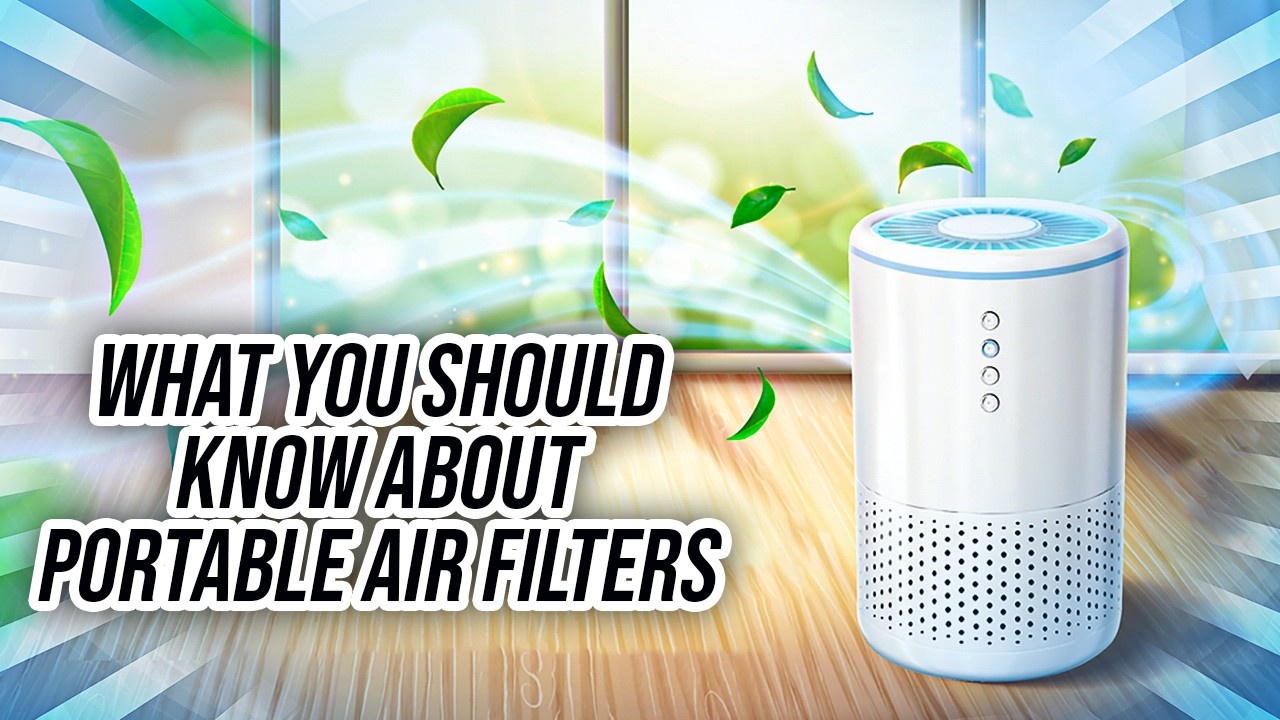
Hello, my name's Dr. Cameron Jones and I'm an environmental microbiologist and public health scientist. And this week, we're going to be looking at an extremely important non-pharmaceutical intervention for the prevention of respiratory diseases. And yes, of course, many of you in Australia would be aware that in New South Wales and Victoria to a greater or lesser extent, the states are opening up. Now, one of the things, if any of you have been following this in the mainstream media is the fact that the governments are about to introduce indoor air quality as something which is extremely significant for especially schools to be aware of. And because every day in my job working with water damaged and mold affected buildings, I know firsthand the value of HEPA air purifiers. But what are they? How do they work? Are some better for you? Do some work more efficiently?
What do you need to look out for when you jump online or go back to your favorite high street retailer for portable electrical goods? What do you need to know? So that's the topic of the live stream today. And to explain this, what you should know about portable air purifiers? And when I was putting all the research together to bring this to you, I thought to myself, I thought back to when I was a kid at school. And remember in winter, when you came in from recess or lunchtime, the most coveted spots in the classroom weren't next to the heater. Are we going to see these sorts of behavioral trends with our own children around HEPA air purifiers? And if so, what do you need to know if you work in public health or are responsible for improving the overall air quality in your home or workplace? So that is the topic of today.
And to focus on this, I want to review what has appeared in the mainstream media in the last couple of weeks. You'll see that ABC News ran a story for New South Wales focusing on the fact that parents are asking for stronger ventilation standards ahead of a return to school in New South Wales. And in Victoria, Premier Dan Andrews has supported $190 million package for air purifiers to be rolled out across all public schools when they reopen for Term 4 in order to keep teachers and students safe. And one of the other news channels also reported that the electrical giant Samsung has even needed to charter flights to deliver some of the 51,000 air purifiers that are required to be installed before Term 4 goes back.
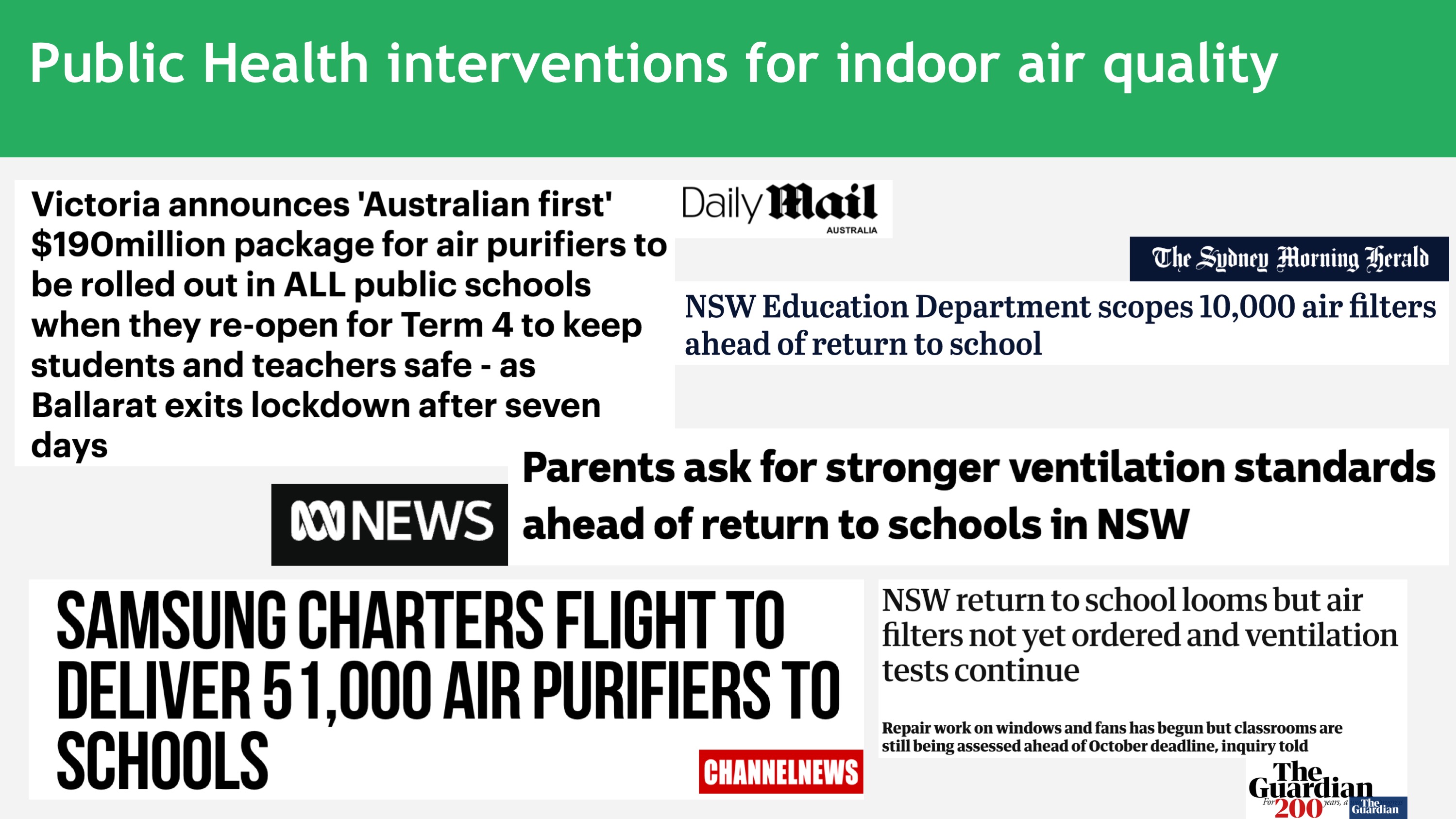
Now that's fantastic, isn't it? Because HEPA air purifiers are a type of filter that as the name suggests captures nasties or germs out of the air space. And this is one of the important non-pharmaceutical interventions, which we need to be aware of. So what does the research literature say? And so what I've done today is I've collected perhaps a half dozen really important articles. I've put all the URLs in the show notes so that you can retrieve these papers yourself and review them. And the first one is looking at this concept of introducing high-efficiency particulate air, but importantly, using portable units. So I'm not focusing on those installations where it's possible to filter the air across a facility like an office, but I'm talking about people going out and purchasing portable air purifiers just like a portable air conditioner or portable heater.
So what does the research say? And this first article is talking about two concepts, which are fundamental to the efficiency of making these units work for you. And the first is containment and concentration. So the risk of transmission of airborne particulate matter, bacteria, yeast, and fungi, and even viruses comes down to the concentration of these in a particular room or volume. So that's the twin message around containment and concentration. So obviously as a public health initiative, there is an urgent need for cost-effective controls apart from vaccines, because as many of you would be aware, there is some hesitancy in the community around vaccination, and there is a real need for engineering controls to minimize the exposure hazards from germs in the air. And the best way to do this is with high-efficiency particulate air. And that's what the acronym HEPA stands for.
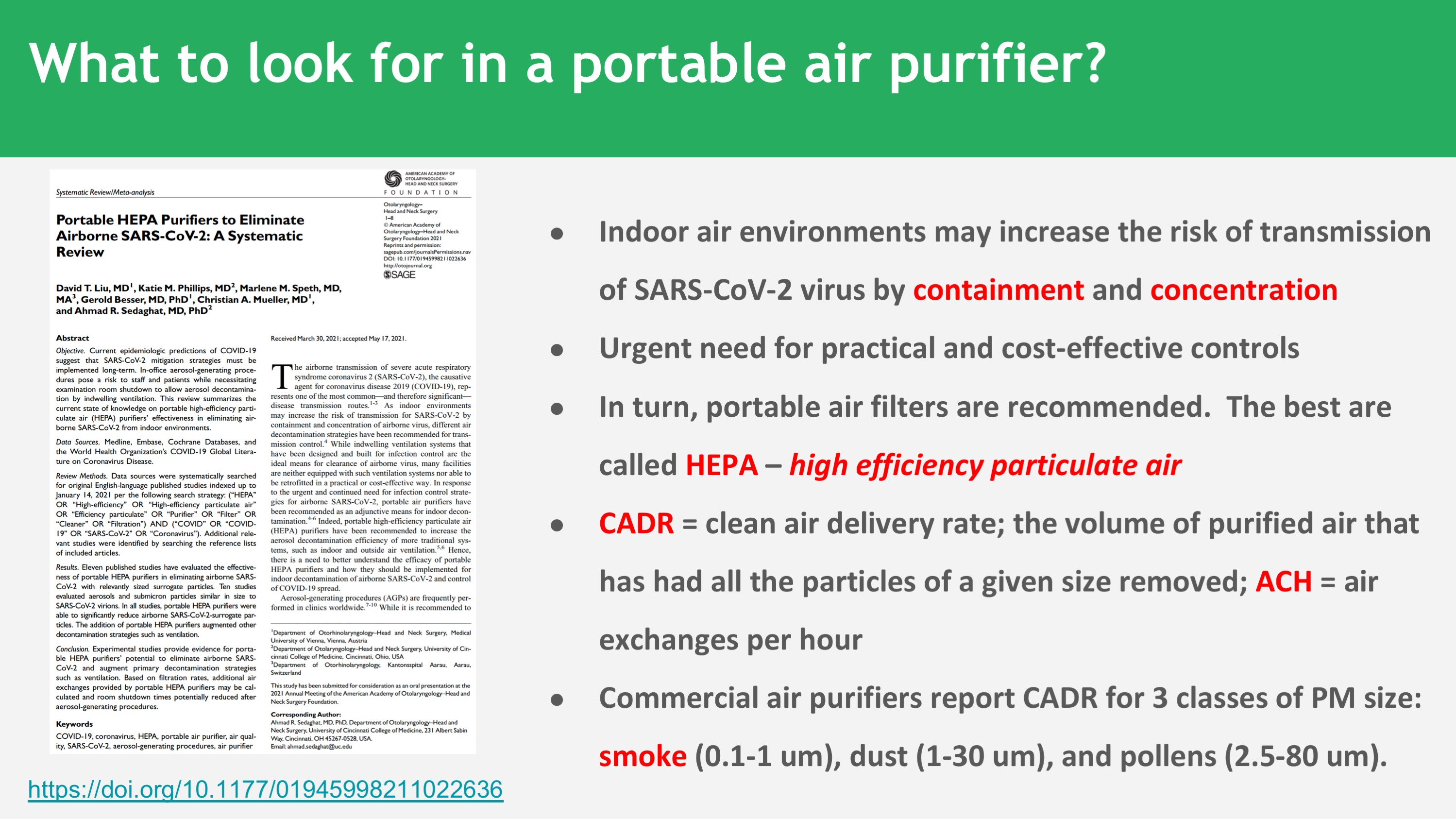
Now, there are two key definitions that I need to explain to you, and they are called ACH and CADR. And CADR or the CADR explains the clean air delivery rate. And that is defined as the volume of purified air that has had all of the particles of a given size removed. Whereas, ACH is the number of air exchanges per hour. And when you're looking on the box or looking at the specifications of a particular portable HEPA unit online, you'll probably see that they describe CADR and ACH in terms of the types of particles. And usually, they don't specify them in terms of germs like bacteria, yeast, fungi, or virus. They're much more cautious. And they talk about the removal efficiency of smoke, for example, which has size 0.1 to 1 micron, dusts between 1 and 30 micron, and so on. Pollens and mold spores are often much larger.
And so when we are looking at this particular topic, I wanted to dive into the literature to find out what's been published around SARS-CoV-2 and how efficient HEPA air purifiers are at that. But before we jump into this, I want to review the value proposition of HEPA for other types of bioaerosols, because in our air, it's not just viruses that we want to reduce. Obviously, we want to reduce other pathogens that could cause either an illness or respiratory illness or even asthma. And so HEPA has a rich history over many decades as being able to effectively filter out particles across the range of size that we are interested in, which is the 0.012 right up to approximately 20 microns. And this defines almost all of the bioaerosols. And I know in all the scope of works that I'm continually writing for water-damaged building interiors and those affected by mold, we use HEPA air to extract these particles from the air space and to reduce the triggering effect of the mold in sensitized individuals.
So I want to go back to that slide and talk about a letter which was sent into a particular journal that was focusing on this issue of HEPA air for the reduction of fungal pathogens. I know that many people who follow me are very interested in improving their indoor air quality so that their living or working space has fewer mold cells in it. And why is this important? Well, obviously it's important in your own home, but what about the literature surrounding the implementation of HEPA in hospitals? And some research quoted in this publication show that there was a 71% reduction in fungal infections in hospitals where HEPA filters are used. And this is the same argument that you'll see in a few minutes. That is the central question around whether or not HEPA is beneficial for the reduction of SARS-containing airspace.
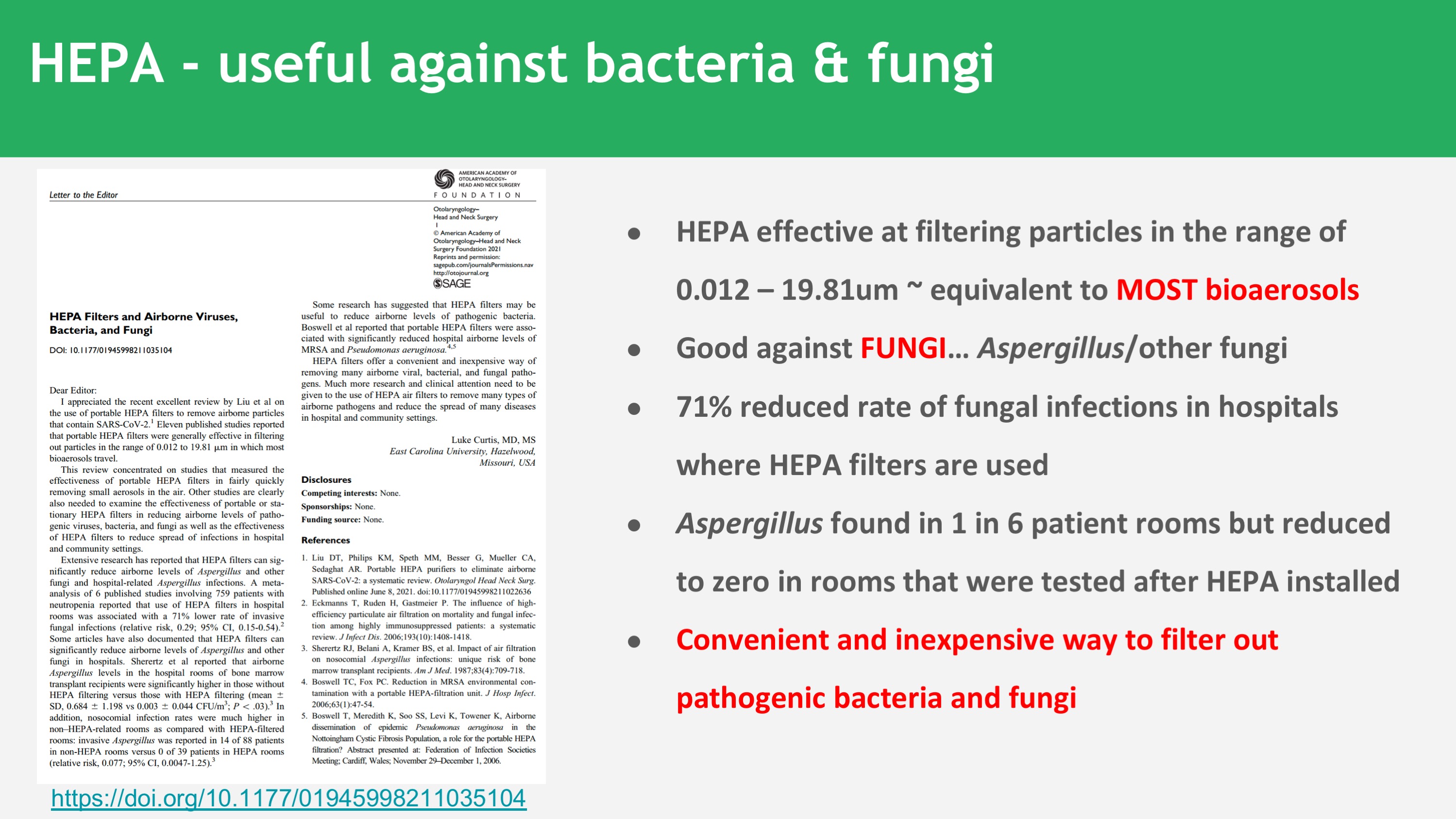
And so looking again at some other statistics for the value proposition for HEPA in patient rooms containing mold, what's the general background level of aspergillus, for example? And the scientists have discovered that approximately one in six patient rooms have an appreciable countable level of aspergillus in it, but that this concentration of mold can be reduced to zero in rooms where HEPA air purifiers are installed. And so the take home message here is that HEPA air purifiers are a convenient and inexpensive way to filter out pathogenic bacteria and fungi. So this is all good news so far, isn't it? But we have to dive a little bit deeper into what the current contemporary research literature is saying about the connection between the implementation of portable HEPA air purifiers and whether or not they help for the COVID crisis that we find ourselves in. And to do this, I want to move on to the next piece of research, which is a publication that came out with this very elegant title, Should homes and workplaces purchase portable air filters to reduce the transmission of SARS-CoV-2 and other respiratory infections?
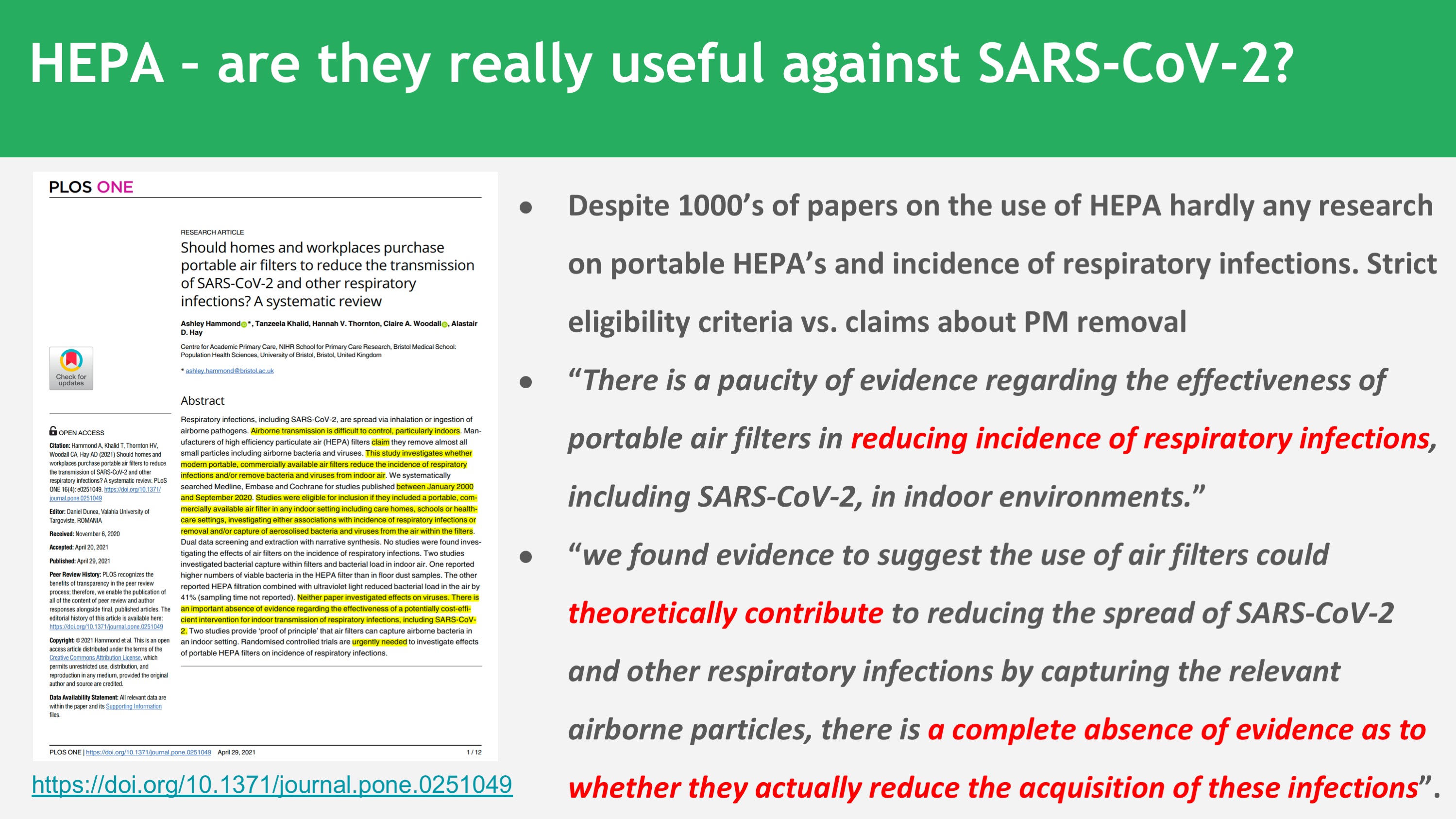
And when I read this, I saw that the word systematic review, and I got very excited because I thought fantastic. Finally, a publication that is going to do justice to the indoor air quality question about the value to public health. However, as I started reading it, they reviewed thousands of papers, but they discovered that there was not good research evidence to show that HEPAs reduce the incidence of respiratory infections. These authors did not include publications focusing on bacteria, yeasts, and fungi. They had very strict eligibility criteria for this review, and they weren't interested in claims about particulate matter (PM) removal. They only wanted to focus on whether there was demonstrable research evidence showing that HEPAs reduce the incidents of respiratory infections. And unfortunately, their conclusions are extraordinarily cautious and they state that "Evidence suggests the use of air filters could theoretically contribute to reducing the spread of SARS-CoV-2 and other respiratory infections by capturing the relevant airborne particles. However, there is a complete absence of evidence as to whether they actually reduce the acquisition of these particular illnesses."
So we have a bit of a problem here. We've got a very well-regarded and respected journal publishing an exhaustive review that only found two studies out of thousands that actually made the connection with the ability to reduce infections. And I recognize one of the reasons why they are being cautious. And I'm going to be talking about that in a moment. But I want to draw your attention to why you should download this publication. Because in it, they have a very good table listing some of the easily obtainable manufacturers of different air purifiers and what their claims are and whether or not there is a link to evidence regarding the efficiency at removing germs and whether or not they link this to an improvement or a reduction in respiratory infections.
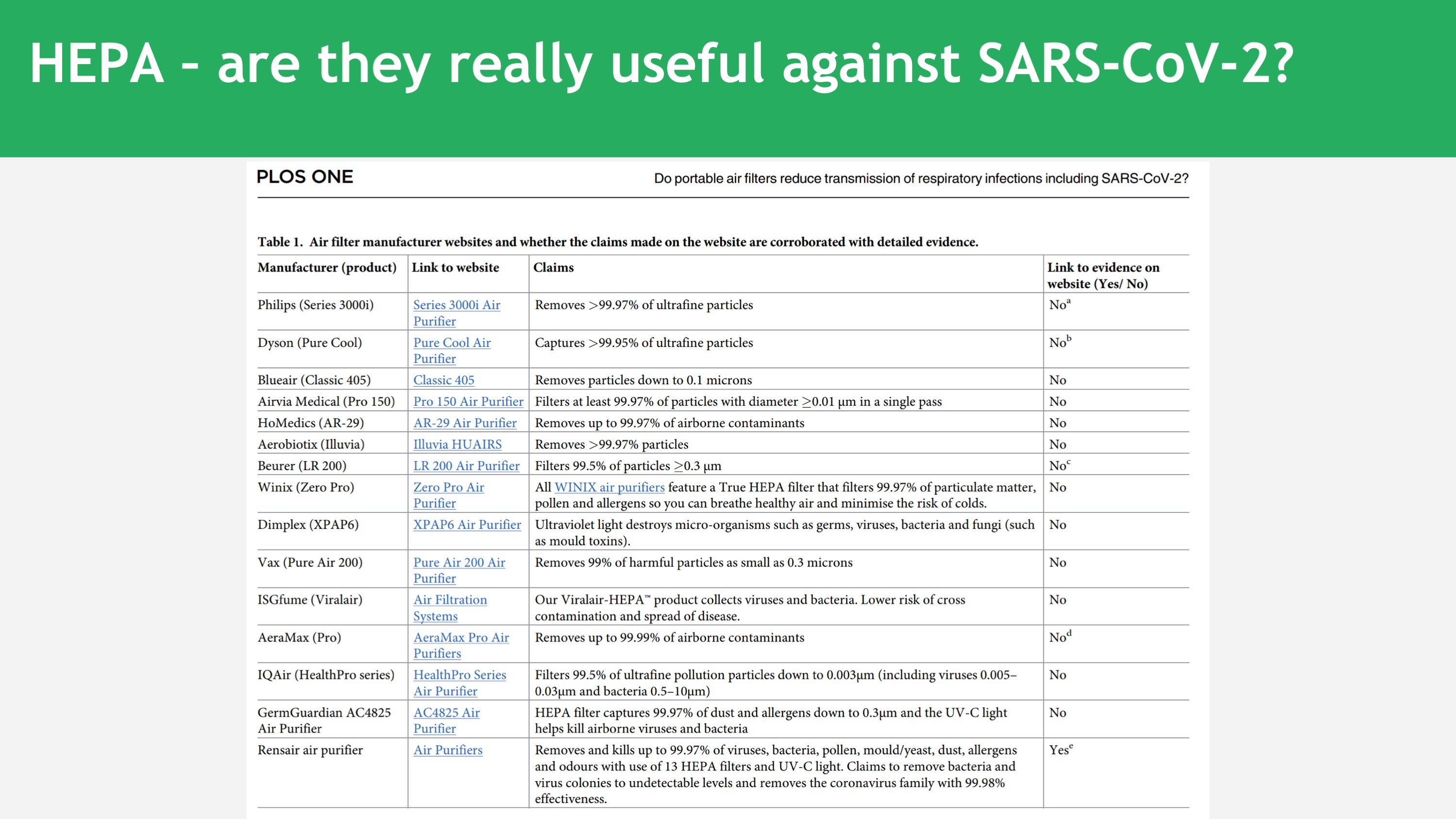
Again, that particular publication is in my view, extraordinarily cautious because they have not considered the wealth of published literature showing HEPA air purifiers being able to remove the particulate matter.
And if you remove the particulate matter from the airspace, that improves respiratory health. And we're going to be going over some of the other literature about this. But what do the Australian policymakers have to say?
Many of you would be familiar with the Burnet model and the Burnet research. And they've had a lot to say throughout the course of this pandemic. And I was interested in two publications that have come out from that group. One of the groups is called OzSage, and they have produced two documents. The first is Protecting children from COVID and making schools and childcare safer. Now, obviously, we all want that for our family and for our community. They also released a related publication focusing on Safe Indoor Air Ventilation Recommendations. Now, I have a few issues with these particular publications, but I'm going to describe this as I go through the good points I see in these publications.
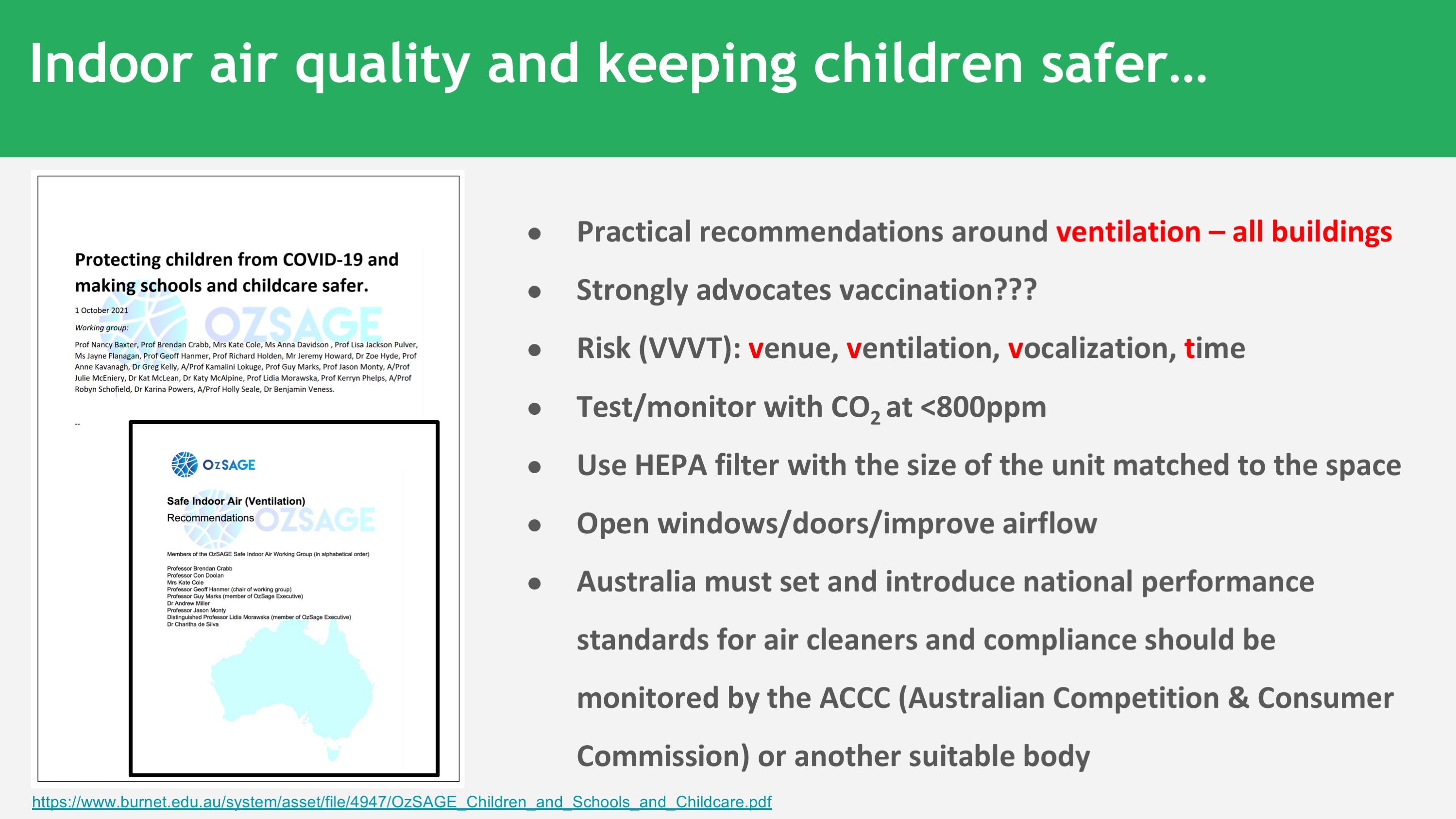
And the first practical recommendation that they put forward is the fact that the question we need to be asking is how efficient is the ventilation in all types of buildings throughout Australia? However, the premise for the OzSage document is really a strong advocate for vaccination. I have no idea why the premise to an indoor air quality document is focusing so much attention on the benefit of vaccination. Vaccination has nothing to do with indoor air quality, whereas indoor air quality affects all people. And so what are some of the good points from these publications? OzSage have put forward a risk matrix, a very simple risk matrix using the acronym VVVT, focusing on what is the venue that you're interested in improving the air quality? What is the existing ventilation used in that particular venue? What are the characteristics of the people who will inhabit that particular venue? How are they vocalizing? Is this speech between individuals? Is it singing? Or is it a public event where there could be shouting? And the time, how long are people spending in that particular venue?
The group puts forward the sensible proposition that schools and public spaces need to start collecting data. However, they only talk about measuring carbon dioxide? Well, this is a bit of a no-brainer. We know from how humans use oxygen and breathe that we give off carbon dioxide. Now, the number or concentration of people in any particular room volume will determine from first principles, how much carbon dioxide is there? However, this particular group is advocating starting to measure carbon dioxide across Australia. I think it would be far more beneficial and efficient that each school started to measure their particulate matter (e.g. PM2.5 and PM10) concentrations and how these build up over the day and week in their individual schools. What are the differences from one building to another? How do the PM2.5 or PM10 levels change? What is the relationship with the proximity of roads, the concentration of students? That is a far more valuable thing to measure rather than carbon dioxide?
However, I digress. The conclusions in OzSage state that it's important that the HEPA air purifier unit is well matched to the space in which it's going to be used. Well, obviously this is really important. And when I extracted some of the headlines from the mainstream media talking about buying units, I'm highly concerned that schools are going to use one or two units in very large spaces and really hope for the best. The conclusion made by OzSage is that Australia must set and introduce national performance standards for air cleaners and compliance should be monitored through the Australian Competition and Consumer Commission or another suitable body. Now, essentially that's just passing the buck and telling the government to start looking at the claims made by the portable air purifier companies that are selling these into Australia. However, isn't the question more important to answer, what are the characteristics of the buildings that need to improve their indoor air quality?
And I come back to the fact that you need to measure the fine (PM2.5) and coarse (PM10) particulate matter levels in these rooms and buildings. And that is a far better, fine-grained approximation/measurement for exactly what's going on with your air quality in any particular room. And I don't think the onus of responsibility should be on those who are selling units. I think the onus of responsibility should be on collecting valid worthy data on which to make decisions.
Let's move away from Australia now. And let's look at some of the research, which has validated the fact that HEPA air purifiers are of benefit to remove the virus that we're all scared of from those situations that are acute. And what are those acute situations? Well, this particular publication that came out in the journal, Science of the Total Environment was looking at introducing portable air purifiers directly into households where people were quarantined because they had COVID.
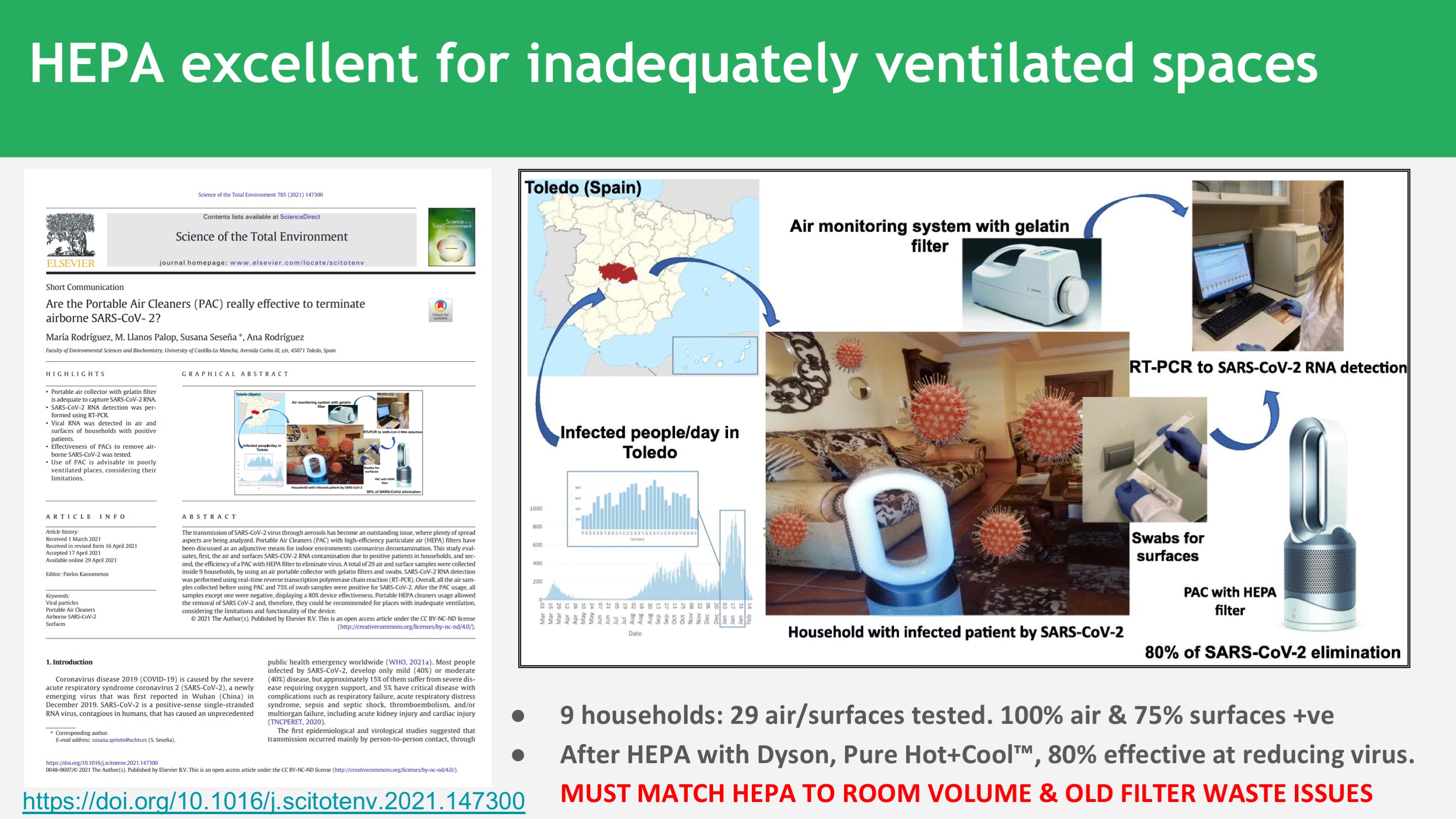
And so what the scientists did is that they introduced and tested the air purifiers before and after their introduction. So like we do when we're measuring mold spore concentrations across buildings, we use a pump to collect air. And in this situation, they used a pump to collect the air onto a gelatin filter. And rather than measuring mold spores, they're actually using PCR to quantify the concentration of virus in the air and also on surfaces. And they found that in nine households where individuals had COVID and were quarantined, 29 of the air surfaces were tested as well, and they found that 100% of the air samples were positive for SARS-CoV-2 virus and 75% of the surfaces, which really puts paid to the argument that fomites or surface-based transmission is not a valid method of acquiring the virus. But again, that's a topic to revisit in another live stream.
So what were the results? After the HEPAs were introduced, they were found to be 80% effective in removing or eliminating the SARS-CoV-2 virus in these homes. And the takeaway conclusion is that it is important to match the HEPA to the room volume. And now, we're getting to some of the problems that can occur with HEPA. Old filter wastes are a problem. And we really need to focus some discussion on this issue, because think about why HEPA air purifiers could run into trouble. If they run all the time and people are relying on these to clean the air, then if those filters are effectively working, they're going to build up some problems over time. In any case, before we get to my takeaway points that I want you to be aware of, I want to review some other positive publications that move away from the ability of air purifiers to remove germs.
And I just want to talk about what we know about when HEPA air purifiers are introduced into people's homes and what better cohort group than pregnant women. And the question here is, is there a connection between gestational exposure to particulate matter air pollution and outcomes like childhood obesity? And childhood obesity is related to a whole range of adverse health issues like high blood pressure, type 2 diabetes, asthma, reduced lung function, and even depression.
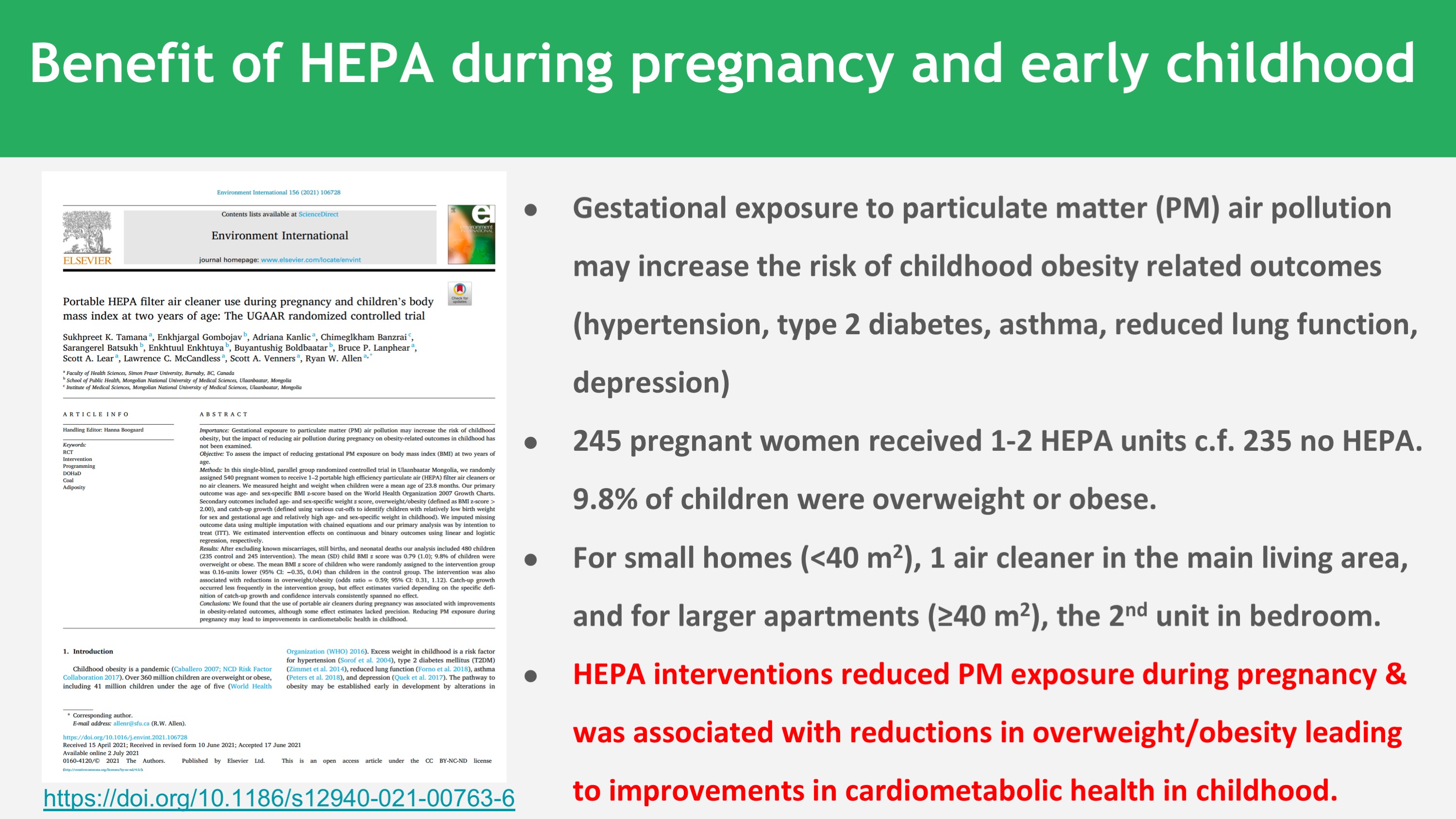
So having the ability to introduce something into the home that can have a long-term benefit to people is really good evidence when we're considering whether or not to take advantage of portable HEPA air purifiers. And so what did this experiment do? It was published in the Environment International journal. And what they did was 245 pregnant women received one or two portable HEPA air purifiers. And the control group was 235 pregnant women who did not receive HEPA air purifiers.
And they tracked these women through their pregnancy, through birth, and for the first two years of the child's life. They found that at the conclusion that nearly 10% of the children were overweight or obese. And what they did was small apartments or homes less than 40 square meters received one air cleaner that was placed in the main living area. Whereas for larger apartments, greater than 40 square meters, a second unit was placed into the bedroom. And the conclusion of this research showed that HEPA interventions reduced particulate matter exposure during pregnancy and was associated with reductions in overweight and obesity leading to improvements in cardiometabolic health in children. Now, I think this is just fantastic evidence on which to hang your hat and move strongly towards those groups of people who believe in the value of improving indoor air quality. Now, I recognize that many scientists and clinicians are very cautious about supporting research that is a non-pharmaceutical intervention.
And I think we need to understand that the scientific literature is certainly polarized to some degree around the fact that there is such strong government push towards vaccination often at the expense of significant research findings that show that the non-pharmaceutical interventions are massively important, and we need to consider those as well. Now, as we round out towards the conclusion, I need to tell you about what you need to be watching out for, because there are some problems that all of us could run into when using HEPA air purifiers in our homes and workplaces. And to understand this, we must recognize that HEPAs can't always work efficiently. If any of you have seen a discarded cigarette filter butt, you know and you can understand the concept that over time they get full. And that means that the filter does not work as efficiently. And over time, skin cells and bacteria and fibers and mold spores clog up the filter, and it can't work as efficiently.
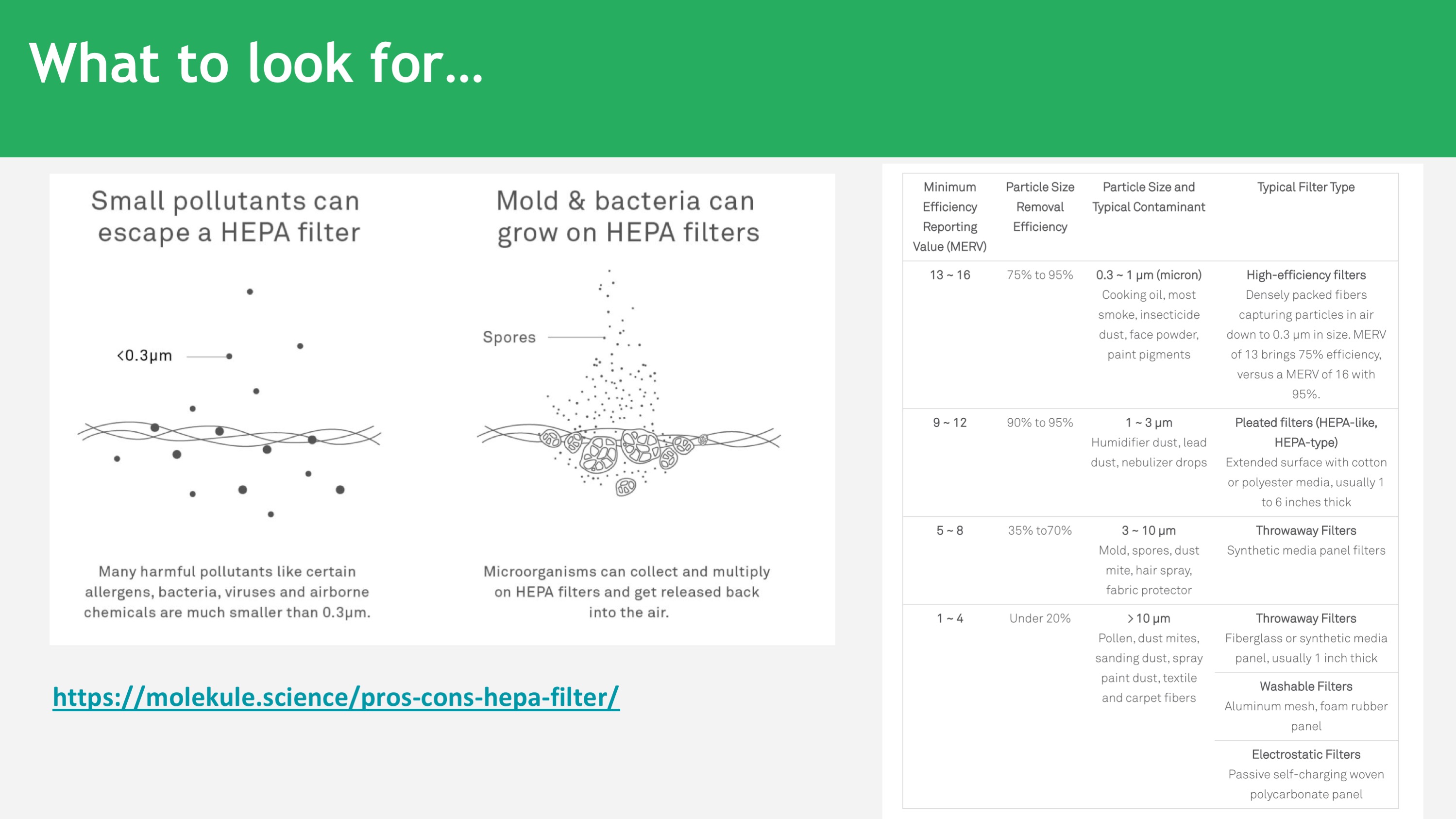
Many times, mold remediators ring me and want me to explain why their post-remediation verifications might have failed. And I always ask them, did you change the HEPA air filter? Did you change the pre-filter? And often there's silence. And I explain to them that the filters were probably clogged. You could be reintroducing material, fine particles, infectious material even into the air space that you're trying to clean. So it's very important that you understand that the filter is being impacted on with force. The air is going through it, and it's being filtered. The newer the filter, the better the outcome. The older the filter, the higher the probability that things will get through. And remember, the SARS-CoV-2 virus is very small. Many of the arguments against HEPA are the same arguments used against masks. And those arguments are, well, the virus is so small. It flies right through.
Well, theoretically, that's true. But the fact is that many of these filters are a three-dimensional object and the weave of the filter material returns the virus, which many times is hitching a ride on particulate matter. And as that particulate matter on the aerosols moves into the filter, there is an increasing probability that it will in fact be removed. So one other thing that you need to be aware of is something called the Minimum Efficiency Reporting Value or the MERV value. And this is a different way of defining and describing the efficiency with which different sizes of particles are removed. So just be aware that not all filters are effective. Those that are HEPA rated come with a definition, meaning that they filter sizes down to a particular size, and that's good for you. So you always want HEPA over a different type of low MERV-rated filter. And often washable filters aren't going to be as efficient as different types of filters that are designed for single use.
Now, I want to end this presentation with some very elegant research that has been done in an animal model showing the extraordinary impact of HEPA air purification. And I'm going to quickly move into discussing this slide because I was very happy when I found this publication because it really underpins the value proposition of non-pharmaceutical interventions, engineering controls for improving indoor air quality in our homes and workplaces. And this particular publication came out in a journal from the Society of Toxicology, and it was looking at a mouse model. And the premise and proposition is that particulate matter is known to contribute to depressive symptoms in mice. And so these scientists were looking at whether or not depressive behavior could be connected with measures or biomarkers, pro-inflammatory and anti-inflammatory cytokine levels. So they set out to design an experiment with these mice. And what they did is they got two groups of mice. Very simple experiment. And they exposed the mice, one group to HEPA filtered air for 12 weeks.
And they found that after just one month that those mice that were exposed to HEPA filtered air produced an antidepressant effect, and it was measurable in their behavior. Whereas those mice that had ambient air exposure, just normal air showed much more depressive symptoms.
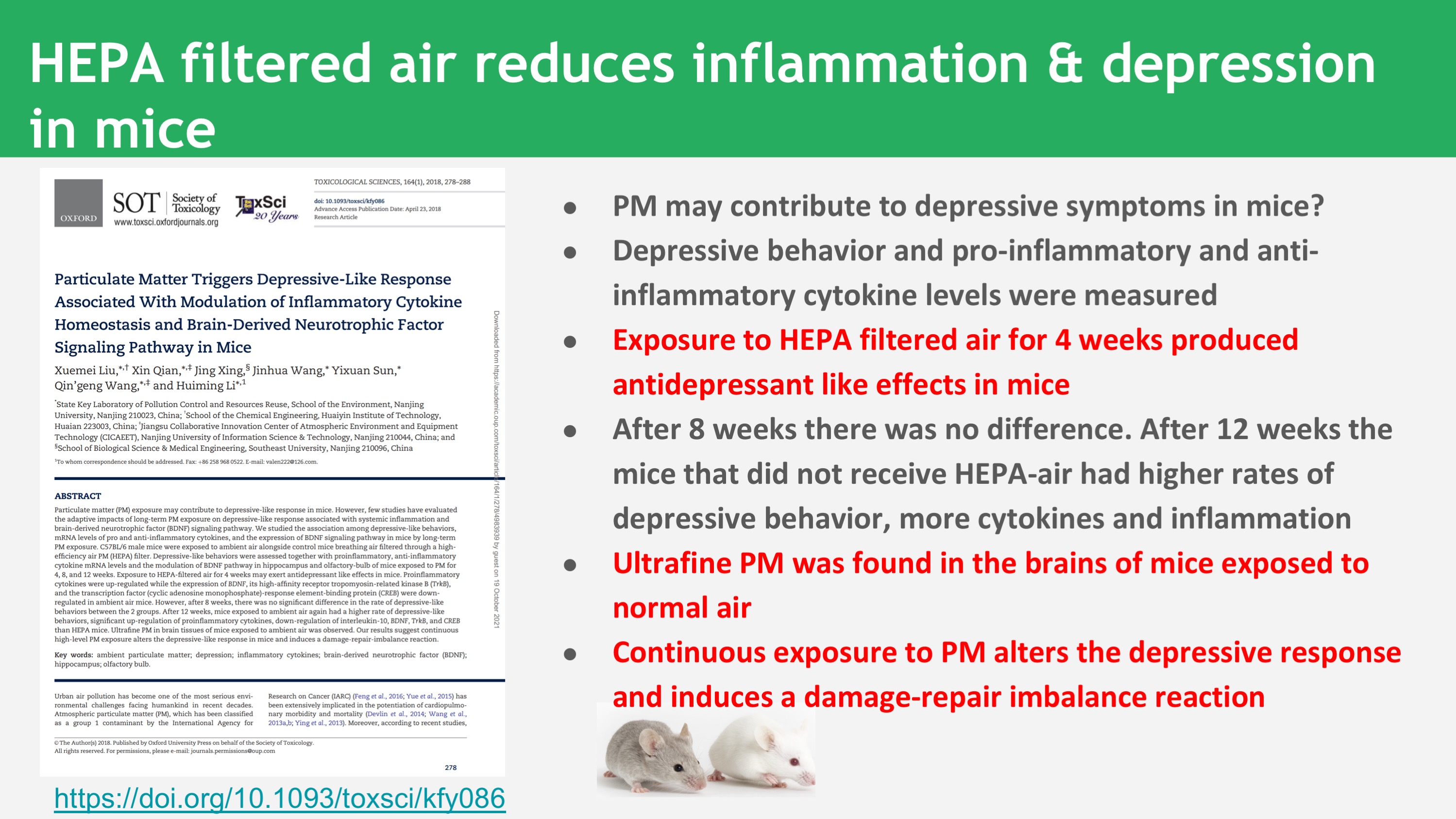
However, after eight weeks, two months, amazingly, there was no difference seen in the antidepressant effect. And so the mice bodies, their physiology seems to adapt after two months where the antidepressant effect is not so obvious and wasn't statistically significant, but it is significant after one month. So early intervention, early improvement of indoor air quality is good for the mice. But the really important breakthrough data points shown throughout this publication is that after 12 weeks, the mice that did not receive HEPA air had higher rates of not only depressive behavior, but more cytokines and inflammatory markers.
They carried out autopsies on these mice and they found that ultrafine particulate matter was found in the brains of mice exposed to the normal polluted air. And the take-home message is that continuous exposure to particulate matter alters the depressive response and induces a damage-repair imbalance reaction.
So there you have it. I've canvassed a lot of the contemporary research into HEPA portable air purifiers. I've shown you some elegant research with mice showing that HEPA air reduces depressive behaviors. I've shown you research in pregnant women showing that HEPA purified air has a significant impact on children into the future and on their obesity scale. And that's really important to be aware of. I've shown you research that introducing portable HEPA air purifiers directly into homes where people are sick with SARS-CoV-2 reduces the concentration of this virus, aerosols from the airspace, reducing it by 80%.
I've shown you some of the very cautious research surrounding whether or not there is a connection with improving or reducing the probability of a respiratory illness. And we've covered some of the first principles of HEPA air purifiers. Some of the definitions you need to be aware of. In any case, those are my arguments for HEPA air purifiers. I think that they are a fantastic engineering initiative that all of us should take advantage of. They are a non-pharmaceutical intervention. There is great research literature for decades showing their benefit to you and your family. And I'm looking forward to Australian research coming out in the coming months to years, showing that these types of positive interventions have really had a significant public health benefit to the community. So I'm going to look forward to that research. And I hope this has been of use to you. I'll see you next week. Bye for now.
WATCH THE LIVESTREAM:
REFERENCES:
1. Hammond A, Khalid T, Thornton HV, Woodall CA, Hay AD (2021) Should homes and workplaces purchase portable air filters to reduce the transmission of SARS-CoV-2 and other respiratory infections? A systematic review. PLoS ONE 16(4): e0251049. https://doi.org/10.1371/journal.pone.0251049
2. Rodríguez, M., Palop, M., Seseña, S. and Rodríguez, A., 2021. Are the Portable Air Cleaners (PAC) really effective to terminate airborne SARS-CoV-2?. Science of The Total Environment, 785, p.147300.
https://doi.org/10.1016/j.scitotenv.2021.147300
3. Protecting children from COVID-19 and making schools and childcare safer.
https://www.burnet.edu.au/news/1523_ozsage_advice_on_protecting_children_from_covid_19
https://www.burnet.edu.au/system/asset/file/4947/OzSAGE_Children_and_Schools_and_Childcare.pdf
https://ozsage.org/ventilation-and-vaccine-plus/
4. Tamana, S., Gombojav, E., Kanlic, A., Banzrai, C., Batsukh, S., Enkhtuya, E., Boldbaatar, B., Lanphear, B., Lear, S., McCandless, L., Venners, S. and Allen, R., 2021. Portable HEPA filter air cleaner use during pregnancy and children's body mass index at two years of age: The UGAAR randomized controlled trial. Environment International, 156, p.106728.
5. Curtis L. HEPA Filters and Airborne Viruses, Bacteria, and Fungi. Otolaryngology–Head and Neck Surgery. July 2021. doi:10.1177/01945998211035104
6. Liu DT, Phillips KM, Speth MM, Besser G, Mueller CA, Sedaghat AR. Portable HEPA Purifiers to Eliminate Airborne SARS-CoV-2: A Systematic Review. Otolaryngology–Head and Neck Surgery. June 2021. doi:10.1177/01945998211022636
7. Enkhbat, U., Gombojav, E., Banzrai, C. et al. Portable HEPA filter air cleaner use during pregnancy and children’s behavior problem scores: a secondary analysis of the UGAAR randomized controlled trial. Environ Health 20, 78 (2021). https://doi.org/10.1186/s12940-021-00763-6
8. Liu X, Qian X, Xing J, Wang J, Sun Y, Wang Q, Li H. Particulate Matter Triggers Depressive-Like Response Associated With Modulation of Inflammatory Cytokine Homeostasis and Brain-Derived Neurotrophic Factor Signaling Pathway in Mice. Toxicol Sci. 2018 Jul 1;164(1):278-288. doi: 10.1093/toxsci/kfy086. PMID: 29688525.

